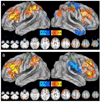Increased functional connectivity between cortical hand areas and praxis network associated with training-related improvements in non-dominant hand precision drawing
- PMID: 27212059
- PMCID: PMC4903896
- DOI: 10.1016/j.neuropsychologia.2016.05.016
Increased functional connectivity between cortical hand areas and praxis network associated with training-related improvements in non-dominant hand precision drawing
Abstract
Chronic forced use of the non-dominant left hand yields substantial improvements in the precision and quality of writing and drawing. These changes may arise from increased access by the non-dominant (right) hemisphere to dominant (left) hemisphere mechanisms specialized for end-point precision control. To evaluate this prediction, 22 healthy right-handed adults underwent resting state functional connectivity (FC) MRI scans before and after 10 days of training on a left hand precision drawing task. 89% of participants significantly improved left hand speed, accuracy, and smoothness. Smoothness gains were specific to the trained left hand and persistent: 6 months after training, 71% of participants exhibited above-baseline movement smoothness. Contrary to expectations, we found no evidence of increased FC between right and left hemisphere hand areas. Instead, training-related improvements in left hand movement smoothness were associated with increased FC between both sensorimotor hand areas and a left-lateralized parieto-prefrontal network implicated in manual praxis. By contrast, skill retention at 6 months was predicted by changes including decreased FC between the representation of the trained left hand and bilateral sensorimotor, parietal, and premotor cortices, possibly reflecting consolidation and a disengagement of early learning processes. These data indicate that modest amounts of training (<200min total) can induce substantial, persistent improvements the precision and quality of non-dominant hand control in healthy adults, supported by strengthened connectivity between bilateral sensorimotor hand areas and a left-lateralized parieto-prefrontal praxis network.
Keywords: FMRI; Humans; Laterality of motor control; Learning; Movement; Training.
Copyright © 2016 Elsevier Ltd. All rights reserved.
Figures





Similar articles
-
Changes in cortical, cerebellar and basal ganglia representation after comprehensive long term unilateral hand motor training.Behav Brain Res. 2015 Feb 1;278:393-403. doi: 10.1016/j.bbr.2014.08.044. Epub 2014 Sep 3. Behav Brain Res. 2015. PMID: 25194587
-
Planning Functional Grasps of Simple Tools Invokes the Hand-independent Praxis Representation Network: An fMRI Study.J Int Neuropsychol Soc. 2017 Feb;23(2):108-120. doi: 10.1017/S1355617716001120. J Int Neuropsychol Soc. 2017. PMID: 28205496
-
Brain changes following four weeks of unimanual motor training: Evidence from behavior, neural stimulation, cortical thickness, and functional MRI.Hum Brain Mapp. 2017 Sep;38(9):4773-4787. doi: 10.1002/hbm.23710. Epub 2017 Jul 5. Hum Brain Mapp. 2017. PMID: 28677224 Free PMC article.
-
Motor learning in man: a review of functional and clinical studies.J Physiol Paris. 2006 Jun;99(4-6):414-24. doi: 10.1016/j.jphysparis.2006.03.007. Epub 2006 May 26. J Physiol Paris. 2006. PMID: 16730432 Review.
-
Integrated technology for evaluation of brain function and neural plasticity.Phys Med Rehabil Clin N Am. 2004 Feb;15(1):263-306. doi: 10.1016/s1047-9651(03)00124-4. Phys Med Rehabil Clin N Am. 2004. PMID: 15029909 Review.
Cited by
-
Nondominant hand computer mouse training and the bilateral transfer effect to the dominant hand.Sci Rep. 2021 Feb 18;11(1):4211. doi: 10.1038/s41598-021-83770-4. Sci Rep. 2021. PMID: 33603055 Free PMC article.
-
Acquisition of chopstick-operation skills with the non-dominant hand and concomitant changes in brain activity.Sci Rep. 2019 Dec 31;9(1):20397. doi: 10.1038/s41598-019-56956-0. Sci Rep. 2019. PMID: 31892724 Free PMC article. Clinical Trial.
-
Visual-motor contingency during symbol production contributes to short-term changes in the functional connectivity during symbol perception and long-term gains in symbol recognition.Neuroimage. 2021 Feb 15;227:117554. doi: 10.1016/j.neuroimage.2020.117554. Epub 2020 Dec 24. Neuroimage. 2021. PMID: 33359354 Free PMC article.
-
State-dependent associative plasticity highlights function-specific premotor-motor pathways crucial for arbitrary visuomotor mapping.Sci Adv. 2025 May 16;11(20):eadu4098. doi: 10.1126/sciadv.adu4098. Epub 2025 May 14. Sci Adv. 2025. PMID: 40367165 Free PMC article.
-
No Motor Costs of Physical Education with Eduball.Int J Environ Res Public Health. 2022 Nov 22;19(23):15430. doi: 10.3390/ijerph192315430. Int J Environ Res Public Health. 2022. PMID: 36497505 Free PMC article.
References
-
- Andersson J, Jenkinson M, Smith S. Non-linear registration, aka Spatial normalisation FMRIB technical report TR07JA2. FMRIB Analysis Group of the University of Oxford. 2007
-
- Beery K, Beery N. The Beery-Buktenica developmental test of visual-motor integration. 5. Minneapolis: NCS Pearson Inc.; 2004.
-
- Bogdanov S, Smith J, Frey SH. Former Hand Territory Activity Increases After Amputation During Intact Hand Movements, but Is Unaffected by Illusory Visual Feedback. Neurorehabilitation and Neural Repair. 2012;26:604–615. - PubMed
-
- Calford M, Tweedale R. Interhemispheric transfer of plasticity in the cerebral cortex. Science. 1990;249:805–807. - PubMed
Publication types
MeSH terms
Substances
Grants and funding
LinkOut - more resources
Full Text Sources
Other Literature Sources

